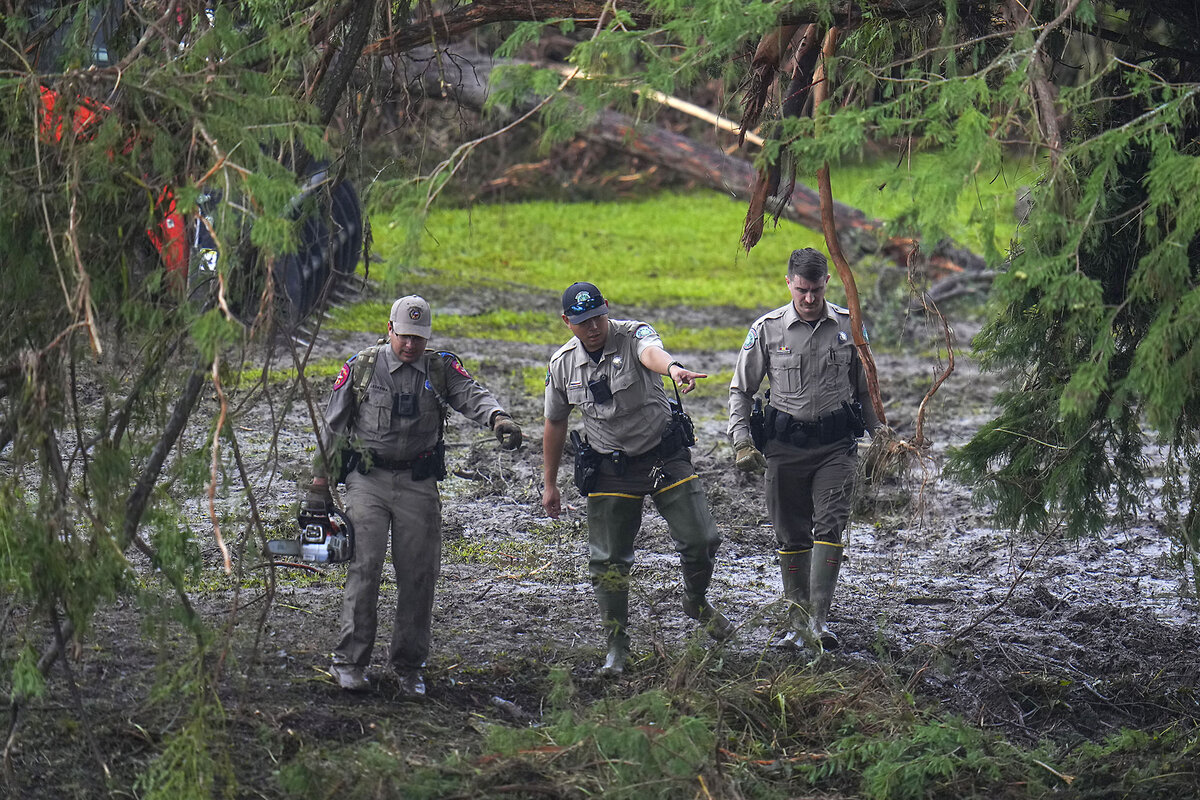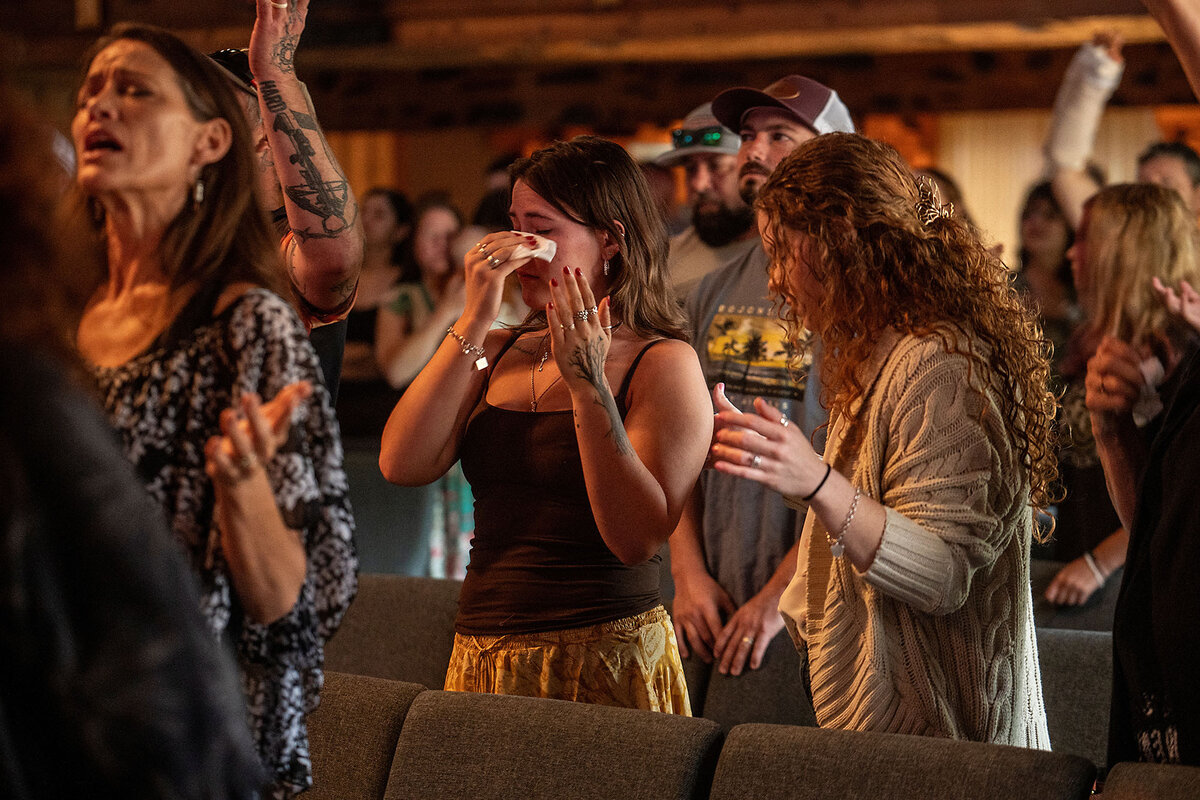After deadly Texas floods, calls rise for better warnings
Loading...
As many as 10 children were still missing late Sunday, nearly three days after the Guadalupe River in south-central Texas rose less than an hour and raged through a summer camp and down a valley popular with vacationers.
Distraught parents had spent the weekend posting photos of their children online, hoping for information, while others rushed to reunification centers set up by rescue workers. President Donald Trump for the area, and authorized the Federal Emergency Management Agency to start working with state and local officials, who have deployed hundreds of search and rescue personnel and first responders to the area. And by the end of the weekend, a growing number of residents, politicians, and meteorologists were asking how people missed warnings about the flood waters ã and what needs to happen to prevent the next tragedy.
Fridayãs flash flood was on record in Kerr County. Conditions aligned for what local meteorologists described as a worst-case scenario, in a region where topography heightens the risk of flash floods. Heavy rains stalled over the area after a period of drought, which left hard-packed ground unable to absorb water quickly. The storm intensified overnight, so the most urgent warnings from the National Weather Service came in the early morning hours as people slept.
Why We Wrote This
Many meteorologists say forecasts were prompt and sound regarding the risks that accompanied heavy rains Friday. But questions are emerging about how to provide better warnings in a Texas region known as ãflash flood alley.ã
Officials say more than 80 people, including at least 28 children, died in those waters, which swept away trees, cars, and houses. More than were rescued.
ãWe will not stop until every single person is found,ã Kerr County Sheriff Larry Leitha said at a press conference on Saturday.
Even as rescue efforts were underway, some officials and commentators began questioning whether residents and campers should have had more warning about the floods. Some local officials blamed weather forecasters for not predicting the voluminous amount of rain; others pointed fingers at Trump administration cuts to the National Weather Service, which critics have worried would hamper the ability of meteorologists to gather and transmit accurate information. Still others pointed to climate change and the increase in extreme rain events.
The reality is complicated, says Jess Neumann, a hydrologist at the University of Reading in the United Kingdom, who studies how communities prepare for and respond to extreme flooding.
Although a warming atmosphere is bringing a greater likelihood of the type of rains that cause flash flooding, few communities ã or institutions ã practice responding to floods as they might for an earthquake or fire. It is often up to local municipalities to have alert sirens or other systems to warn residents about flooding. (Indeed, Kerr Countyãs top elected official, Judge , told reporters that before he was elected, the county had considered a siren system for flash flooding but didnãt go through with it because of cost.) Translating forecasts into action on the ground is difficult but, Dr. Neumann says, increasingly essential across the world.
ãThe thing that frustrates me is that we hear people saying things [after flooding events] like, ãIt was an unprecedented amount of rain, we were not able to take the action that was required,ãã she says. ãOr that people were not prepared. But how many times are we going to hear about people literally being washed away and killed? We need to start thinking outside of the box and changing the way we issue our warnings and how we communicate and help people prepare, because itãs not acceptable to just keep saying we didnãt expect this.ã
It is not unusual for the commentary after a disaster to start breaking down along ideological lines, with finger pointing in predetermined directions. But as with other disasters, from devastating wildfires in Los Angeles earlier this year to the hurricanes that flooded Florida last fall, the reality is nuanced.
Here are a few of the questions already swirling around the Texas disaster, even as Republican Rep. Chip Roy of Texas urged people to ãpause, take a breath for the recriminations and the Monday morning quarterbacking.ã
Did weather forecasters do their job ahead of the floods?
Over the weekend, Texas officials claimed that weather forecasters underestimated the amount of water that would hit the region. Nim Kidd, chief of the Texas Division of Emergency Management, said at a press briefing that the National Weather Service advisory issued Thursday ãdid not predict the amount of rain we saw.ã Other officials made similar claims.
But many meteorologists across the country say that the National Weather Service predictions were both sound and timely. Forecasters did predict fewer inches of rain to fall than what ultimately came down in Kerr County. But on Thursday, that ãrainfall totals of 1 to 3 inches appear likely, but locally higher amounts upwards of 5 to 7 inches could materialize if slow-moving storms begin to cluster.ã They also put a flood watch into effect for Texasãs southwestern Hill Country, and noted that "models remain in disagreement" over where the rains would be heaviest.
Twelve inches of rain ended up falling in some locations.
By early Friday morning, the National Weather Service was issuing ãlife threateningã flash flood warnings for the area. Shortly after 5:30 a.m. it issued an alert that a ãlarge and deadly flood wave is moving down the Guadalupe River.ã
But by that time Camp Mystic, a ¤È§úǵèþ sleepaway camp for girls near Kerrville, had already been hit by the floods. And the warnings ran up against what meteorologists call the ãlast mile gapã ã the challenge of effectively, and quickly, communicating weather information to those people who need it. Flood alerts buzz on phones, the same way as a tornado warning. But those donãt help if cellphones are out of range, or if alerts are turned off.
ãThe warnings were prompt,ã says Bob Henson, a meteorologist with Yale Climate Connections. ãThey were issued covering the affected areas. All those boxes were checked by the National Weather Service, but the NWS canãt make sure that the messages get to every person at risk.ã
Localities could have warning sirens, some experts said, or policies where local officials go to residences to warn individuals about potential disaster.
Did DOGE cuts lead to gaps in the weather forecasting?
A narrower line of critique this weekend was that the Trump administrationãs cuts to the National Oceanic and Atmospheric Administration (NOAA) and its National Weather Service may have hindered the forecasts or warnings.
Earlier this year, the president and his Department of Government Efficiency cut 10% of NOAAãs staff, including 600 National Weather Service employees. Several hundred more took early retirements, including Paul Yura, the warning coordination meteorologist at the National Weather Service Austin-San Antonio office ã the region where this weekendãs deadly floods took place.
Critics have warned that the cuts to NOAA would weaken predictions and endanger the public. In May, five former NWS directors from both Democratic and Republican administrations said this in an open letter.
ãOur worst nightmare is that weather forecast offices will be so understaffed that there will be needless loss of life,ã they wrote.
But this past weekend, NWS forecasters did predict flooding. Indeed, for days, they had been warning about heavy localized rains. Tom Fahy, legislative director for the National Weather Service employeesã union, said that while there are staffing shortages at Texasãs San Angelo forecast office and the Austin-San Antonio office, both ãhad adequate staffing and resources as they issued timely forecasts and warnings leading up to the storm.ã
More worrisome, say many meteorologists, is that a similar event could take place in an area where the National Weather Service is more understaffed. Others say Trump administration cuts will affect the data and analysis for predicting events like floods or hurricanes.
ãHaving short staffed NWS offices increases the probability of deadly outcomes for flash flood events,ã says Jeff Masters, co-founder of Weather Underground. ãSo why are we increasing that risk at a time when climate change is making extreme rainfall events more frequent and severe? And why are we cutting funding [for] the research needed for the Weather Service to better forecast extreme rainfall events?ã
Did climate change cause the floods?
Climate scientists say itãs clear that as the earthãs atmosphere gets warmer, extreme rainfall events are becoming more common.
Still, as with any weather event, it is difficult to say that any one storm is ãbecause ofã climate change.
Heavy rains and flooding are not uncommon in this part of Texas. Indeed, the Hill Country is sometimes called ãflash flood alleyã for its catastrophic river risings. In 1987, the Guadalupe River flooded and washed away vehicles carrying summer campers who were trying to evacuate. Ten children died.
There is some debate about the impact of climate change on river floods, which can also be affected by other forms of human engineering.
Still, UCLA climate scientist Daniel Swain ô that the rainfall in Texas Hill Country last week is exactly the sort of weather pattern brought by climate change.
ãThis kind of record-shattering rain (caused by slow-moving torrential thunderstorms) event is *precisely* that which is increasing the fastest in [a] warming climate. So itãs not a question of whether climate change played a role ã itãs only a question of how much,ã he said.







